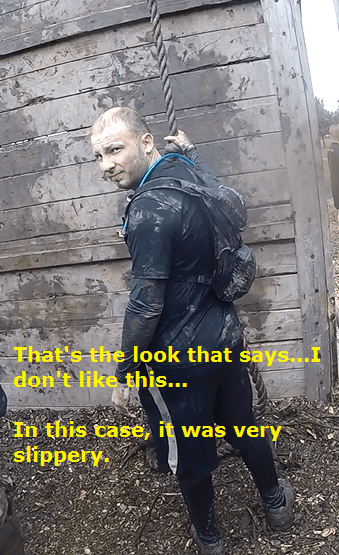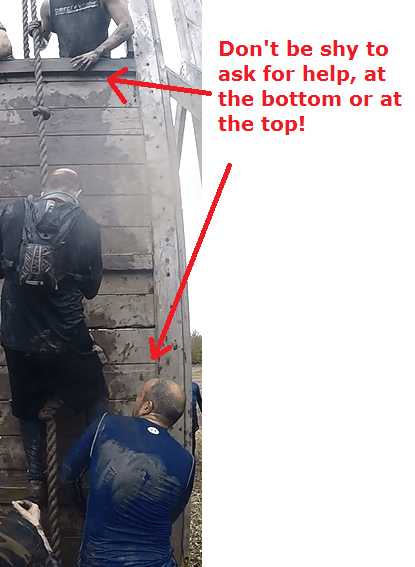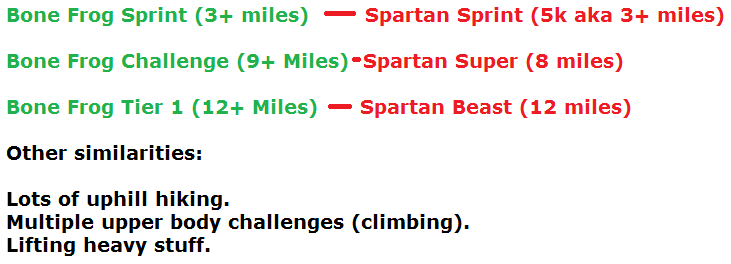One of the biggest surprises to me when I did Tough Mudder was how much more difficult the obstacles turned out to be vs when I researched them. The ones I though would be easiest, particularly the wall climbing challenges, all ended up being much more difficult than I though, specifically the liberator.
Looking back at it, I learned that in the future I will need to research any new mud runs I do and their obstacles and as for the ones on Tough Mudder, the next time I do it, at least I won’t make the same mistakes.
When it came to the liberator, from a distance and from looking at it on videos, it didn’t seem like it would be a problem (don’t know what the liberator is?). After all, what’s so difficult about taking sticks (blunt stakes), sticking them into the holes located all over the wall and just climbing it?
Well when my team and I ran up to it, I was looking at people who were climbing the wall and most of them just couldn’t seem to do it quickly or comfortably. I honestly though it’s because most of them weren’t prepared, but it wasn’t until I got closer that I noticed how deceptive the obstacle really was…
Apparently, the holes they have on the wall don’t all fit the sticks you get and not all of them are the same size, so while you’re attempting to climb this wall, not only are you guessing where the sticks will fit, but as you’re already on the wall itself, your strength is getting zapped from testing which holes fit.
As I was climbing the liberator, I had to improvise my climb and after I got to the top, and started analyzing how next time, I could make it easier, 5 ideas arose.
The 5 ways to climb the liberator:
1) Ask the people who are climbing before you to leave whichever stakes stick well inside the holes so you can have an easier time when it’s your turn.
Technically, you’re supposed to start with your own and figure out which ones fit, but if you meet people before you who are nice enough to leave the good ones inside the wall, you’ll climb the liberator a lot faster.
2) If you don’t want to or can’t “cheat” the challenge and have to figure out which blunt stakes fit, then use the following for leverage:
The liberator wall itself is divided into about 4-5 sections so that many people can climb it at once. The area which divides each section is a wooden pillar and inside each are triangular openings on several areas designed so you can fit your feet in there.
They aren’t that big in size so don’t think you can hold on for long, but they are a little bit bigger than an adult toe and when you wear sneakers, it’ll be even more difficult to fit them inside, but still, if you can get a foot in, you will be able to alleviate your upper body from always having to hold onto your weight and it’ll also give you a little bit of time to test out which holes fit the stake you have.
If you have the strength, you can also use your hands along these walls and push against them to basically keep you held against the wall without falling. I only recommend this if your stakes don’t work long enough for you to hold on.
3) If the stakes don’t fit (which often happens) try to find at least one hole where it does, use that hole to “fall” back on if you can’t get any higher.
Just getting one to fit and using your feet in those triangular openings is enough to keep you at whatever level you’re in at the time for a bit while you figure out how to get higher.
4) You can technically still use the stakes that don’t work and see which holes worked for the people that went before you.
This is kind of what I was using. There aren’t that many options of holes as you’re climbing in your section so it’s not difficult to forget a few areas where the stakes fit in. You can use that to help you get through better, but when it’s your turn, always make sure the ones you use fit perfectly before moving upward as some of the stakes aren’t of the same size.
5) If the holes which worked were in a different section of the wall, if they are close enough, use them.
In my situation, I had a person to my right who managed to find a few firm areas that were able to climb through. Because I was running out of strength, I actually was able to reach the ones in the other section and use them for leverage.
Obviously this happened after they made it to the top so I wasn’t interrupting anyone’s climb as I was doing it.
Do you really need to use all these suggestions on just 1 obstacle?
No, some people may find that they naturally get over the liberator fairly quickly, but there will be the type of people who will be surprised by how slippery and difficult it is to fit the stakes in and use them to climb. Another example of a surprisingly slippery obstacle on Tough Mudder is balls to the wall.
You don’t have to memorize each tip to be prepared for this obstacle, but if you remember a few tips when you get to it, should you get stuck and remember them, you’ll have more ways to get through it and not panic.
And speaking of panicking, while you should be careful when climbing, the liberator isn’t a scary obstacle in my opinion, it is just more technically challenging because of it’s design.
When you do it, don’t try to scale it quickly, be careful with each step you take upward and make sure you have a firm balance with both your feet and hands before moving further up.
I have also heard that Tough Mudder is no longer using this obstacle in 2017, but if it is, at least now, you’re more ready!
Note: I did a second Tough Mudder in 2017 and the Liberator was not there, but there were other cool, new obstacles.








 for it extensively prior to scaling it on
for it extensively prior to scaling it on 
 before attempting to go back down or help others. Consider that the wall can also be very slippery and dangerous so go very slow to make sure you have an excellent foothold and aren’t slipping at all.
before attempting to go back down or help others. Consider that the wall can also be very slippery and dangerous so go very slow to make sure you have an excellent foothold and aren’t slipping at all. 
